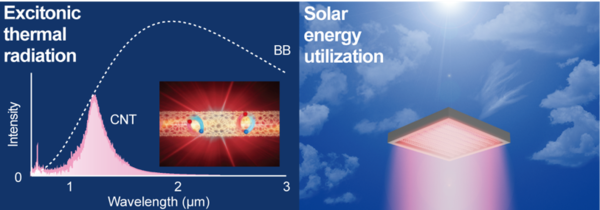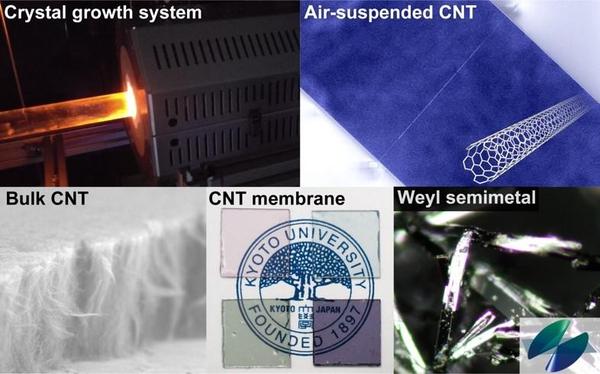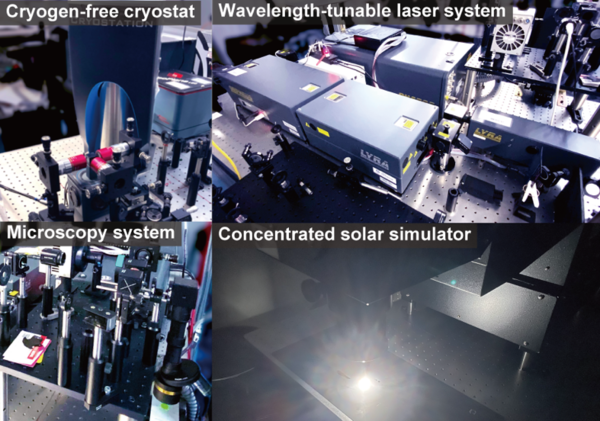Functional Materials Science and Engineering
Advanced Energy Conversion Division Functional Materials Science and Engineering Research Section
Professor : Yuhei MIYAUCHI
Our research focuses on the physical properties of nanoscale/quantum materials and their applications in energy conversion/utilization technologies. In particular, materials science and engineering for highly efficient use of solar light and thermal energy are the subjects of interest.
https://fmse.iae.kyoto-u.ac.jp/en/
Energy science based on the functional properties of nanoscale/quantum materials
Our research focuses on the physical properties, functions, and energy applications of materials that exhibit significant quantum mechanical effects, such as carbon nanotubes (CNT) and recently discovered topological materials. The aim is to create new technologies for highly efficient use of solar light/ thermal energy that will contribute to the realization of a sustainable energy society. To understand the unique physical properties of these materials from the fundamental principles and extract superior functions that exceed the limits of conventional materials, we are promoting interdisciplinary research that covers basic sciences, including condensed matter physics and materials synthesis, as well as thermal, mechanical, electronic, and optical engineering along with the fabrication of integrated materials.
1) Highly-efficient solar energy conversion application of carbon nanotube's quantum thermal optical properties
determine the physical limits of implementable functions. Thus, the emergence of new material systems with unconventional physical properties may bring innovation to various fields including energy science. To find the seeds of this innovation, it is necessary to accumulate basic research on novel physical properties and link the results to the future development of energy science and technology.
As a part of such efforts, we have been developing an innovative solar energy spectrum converter by introducing the latest findings that we have discovered in CNT--generation of narrow-band exciton thermal radiation in high-temperature CNT--to the engineering of thermal radiation control. This research aims to convert broadband solar energy into narrowband energy with high efficiency and apply it to future solar energy utilization technologies, such as highly efficient solar thermal power generation, solar steam generation, and solar thermal material synthesis.
Quantum thermal-photophysical properties of carbon nanotubes and their applications.
Narrow-band thermal exciton emission spectra of semiconducting carbon nanotubes at about 1500 K (left) and schematic of solar energy spectral conversion using the excitonic thermal radiation of a carbon nanotube assembly film(right).
2) Integrated functional nanomaterials for energy applications
When nanomaterials are integrated for use in macroscale engineering, interactions among each component material often cause significant changes in their physical properties. Thus, understanding the physical properties of the individual nanomaterial alone is not sufficient to accurately predict as well as design the physical properties and functions of macroscopic assembly of nanomaterials for their use in engineering. In addition, it is relevant to elucidate the physical properties and functions that emerge in the macroscopic assembly for the design and property control of integrated materials in which nanomaterials are used as building blocks. We are working on the creation of highly functional and high-value-added nanocarbon- integrated materials, such as single chiral structure nanotube assembly and nanotube composites with excellent optical, thermal, electronic, and mechanical properties. This study aims at their applications to high-efficiency solar energy utilization
technology, high-performance thermal management materials, and ultrahigh specific strength materials for extremely fuel-efficient transportation machinery. Further, to develop expensive high-performance nanocarbon materials into low-cost materials that can be used ubiquitously on a global scale, we will promote comprehensive studies such as developing technologies for sustainable procurement of raw materials and energy required for their synthesis.
3) Development of unconventional infrared photoelectric conversion device using quantum materials
We are studying new methods for the synthesis and growth of quantum materials, as well as exploring novel physical properties and functions of such materials to realize high-performance energy conversion technologies that can surpass the physical limits posed by conventional materials. As a research infrastructure for this purpose, our laboratory is equipped with crystal growth systems of various quantum materials and advanced physical property measurement facilities that can perform various spectroscopic measurements, such as time-domain, frequency- domain, spatially-resolved, polarization-resolved, and microcurrent measurements on microscopic samples in a wide temperature range. As a part of the research using such facilities, we are studying infrared photoelectric conversion phenomena due to the unconventional mechanism in topological quantum materials. Ultimately, we aim to develop an efficient direct photoelectric conversion technique for mid-infrared thermal radiation from heat sources such as industrial waste heat, geothermal heat, and domestic waste heat.
Synthesis and assembly of various quantum materials
Broadband optical property measurement systems











